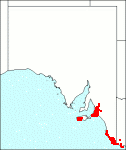Family: Myrtaceae
Leptospermum lanigerum
Citation:
Smith, Trans. Linn. Soc. 3:263 (1797).
Synonymy: Philadelphus laniger Alton, Hort. Kew 2:156 (1789); L. pubestens Lam., Encycl. 3:466 (1791).
, Leptospermum lanigerum, Leptospermum pubescens, Philadelphia laniger Common name: Silky tea-tree, woolly tea-tree.
Description:
Tall shrub to 5 m or more high, the young stems closely pubescent; leaves oblong to narrowly oblanceolate, from a few to 15 mm long, usually grey-pubescent at least on the lower surface, the margins usually recurved, the apex tapering rather abruptly to a short pungent poin.
Flowers c. 15 mm diam., borne at the ends of short densely leafy side-shoots; bracts broad, pale-brown and tending to persist about the flowers; hypanthium usually densely villous, broad above a short narrow base; sepals 2-4 mm long, deltoid to long-deltoid; petals very broadly obovate, white; stamens c. 3 mm long; ovary usually 5-celled, with c. 50 ovules in 4-6 rows in each cell.
Fruit 5-10 mm diam., persistent, the outer surface papery and flaking but ultimately woody; fertile seeds c. 2.5 mm long, narrowly linear-cuneate, their surface longitudinally striate.
Published illustration:
Costermans (1981) Native trees and shrubs of south-eastern Australia, p. 239.
|
|
Distribution:
|
In sandy swamps and along watercourses.
S.Aust.: MU, SL, KI, SE. N.S.W.; Vic.; Tas.
|
Conservation status:
native
Flowering time: Oct. — Jan.
|

SA Distribution Map based
on current data relating to
specimens held in the
State Herbarium of South Australia
|
Biology:
No text
Author:
Not yet available
|

